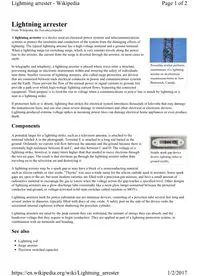
Lightning Arrester-2017 PDF
Preview Lightning Arrester-2017
Powerline worker performs maintenance of a lightning arrester on an electrical transmission tower in New Brunswick, Canada. Simple spark gap device diverts lightning strike to ground (earth). Lightning arrester From Wikipedia, the free encyclopedia A lightning arrester is a device used on electrical power systems and telecommunications systems to protect the insulation and conductors of the system from the damaging effects of lightning. The typical lightning arrester has a high-voltage terminal and a ground terminal. When a lightning surge (or switching surge, which is very similar) travels along the power line to the arrester, the current from the surge is diverted through the arrestor, in most cases to earth. In telegraphy and telephony, a lightning arrestor is placed where wires enter a structure, preventing damage to electronic instruments within and ensuring the safety of individuals near them. Smaller versions of lightning arresters, also called surge protectors, are devices that are connected between each electrical conductor in power and communications systems and the Earth. These prevent the flow of the normal power or signal currents to ground, but provide a path over which high-voltage lightning current flows, bypassing the connected equipment. Their purpose is to limit the rise in voltage when a communications or power line is struck by lightning or is near to a lightning strike. If protection fails or is absent, lightning that strikes the electrical system introduces thousands of kilovolts that may damage the transmission lines, and can also cause severe damage to transformers and other electrical or electronic devices. Lightning-produced extreme voltage spikes in incoming power lines can damage electrical home appliances or even produce death. Components A potential target for a lightning strike, such as a television antenna, is attached to the terminal labeled A in the photograph. Terminal E is attached to a long rod buried in the ground. Ordinarily no current will flow between the antenna and the ground because there is extremely high resistance between B and C, and also between C and D. The voltage of a lightning strike, however, is many times higher than that needed to move electrons through the two air gaps. The result is that electrons go through the lightning arrester rather than traveling on to the television set and destroying it. A lightning arrester may be a spark gap or may have a block of a semiconducting material such as silicon carbide or zinc oxide. "Thyrite" was once a trade name for the silicon carbide used in arresters. Some spark gaps are open to the air, but most modern varieties are filled with a precision gas mixture, and have a small amount of radioactive material to encourage the gas to ionize when the voltage across the gap reaches a specified level. Other designs of lightning arresters use a glow-discharge tube (essentially like a neon glow lamp) connected between the protected conductor and ground, or voltage-activated solid-state switches called varistors or MOVs. Lightning arresters built for power substation use are immense devices, consisting of a porcelain tube several feet long and several inches in diameter, typically filled with discs of zinc oxide. A safety port on the side of the device vents the occasional internal explosion without shattering the porcelain cylinder. Lightning arresters are rated by the peak current they can withstand, the amount of energy they can absorb, and the breakover voltage that they require to begin conduction. They are applied as part of a lightning protection system, in combination with air terminals and bonding. See also ◾ Lightning rod ◾ Surge arrester ◾ Thyristor switched capacitor Page 1 of 2 Lightning arrester - Wikipedia 1/2/2017 https://en.wikipedia.org/wiki/Lightning_arrester External links ◾ "Electrical Devices and How They Work, Part 14: Lightning Arresters (https://books.google.com/books? id=7igDAAAAMBAJ&pg=PT17)" (article about lightning arresters and how they were used in early AC and DC power distribution systems), Popular Science monthly, February 1919, 5 unnumbered pages, scanned by Google Books ◾ OSHA Electric Power eTool: Illustrated Glossary: Lightning Arresters (http://www.osha.gov/SLTC/etools/electric_power/illustrated_glossary/substation_equipment/lightning_arresters.html) ◾ An extensive dictionary of terms used with arresters at ArresterWorks.com (http://www.arresterworks.com/resources/dictionary.php) ◾ History of arresters at ArresterWorks.com (http://www.arresterworks.com/history/pdf_files/History_of_Arresters_on_Power_Systems_1890-1930.pdf) ◾ Graphic Overview of how an arrester works (http://www.arresterworks.com/ArresterFacts_files/ArresterFacts%20009% 20What%20is%20an%20Arrester%20R3.pdf) ◾ NEMA Surge Protection Institute (http://www.nemasurge.com) Retrieved from "https://en.wikipedia.org/w/index.php?title=Lightning_arrester&oldid=744466750" Categories: Lightning Electrical safety ◾ This page was last modified on 15 October 2016, at 11:52. ◾ Text is available under the Creative Commons Attribution-ShareAlike License; additional terms may apply. By using this site, you agree to the Terms of Use and Privacy Policy. Wikipedia® is a registered trademark of the Wikimedia Foundation, Inc., a non-profit organization. Page 2 of 2 Lightning arrester - Wikipedia 1/2/2017 https://en.wikipedia.org/wiki/Lightning_arrester
